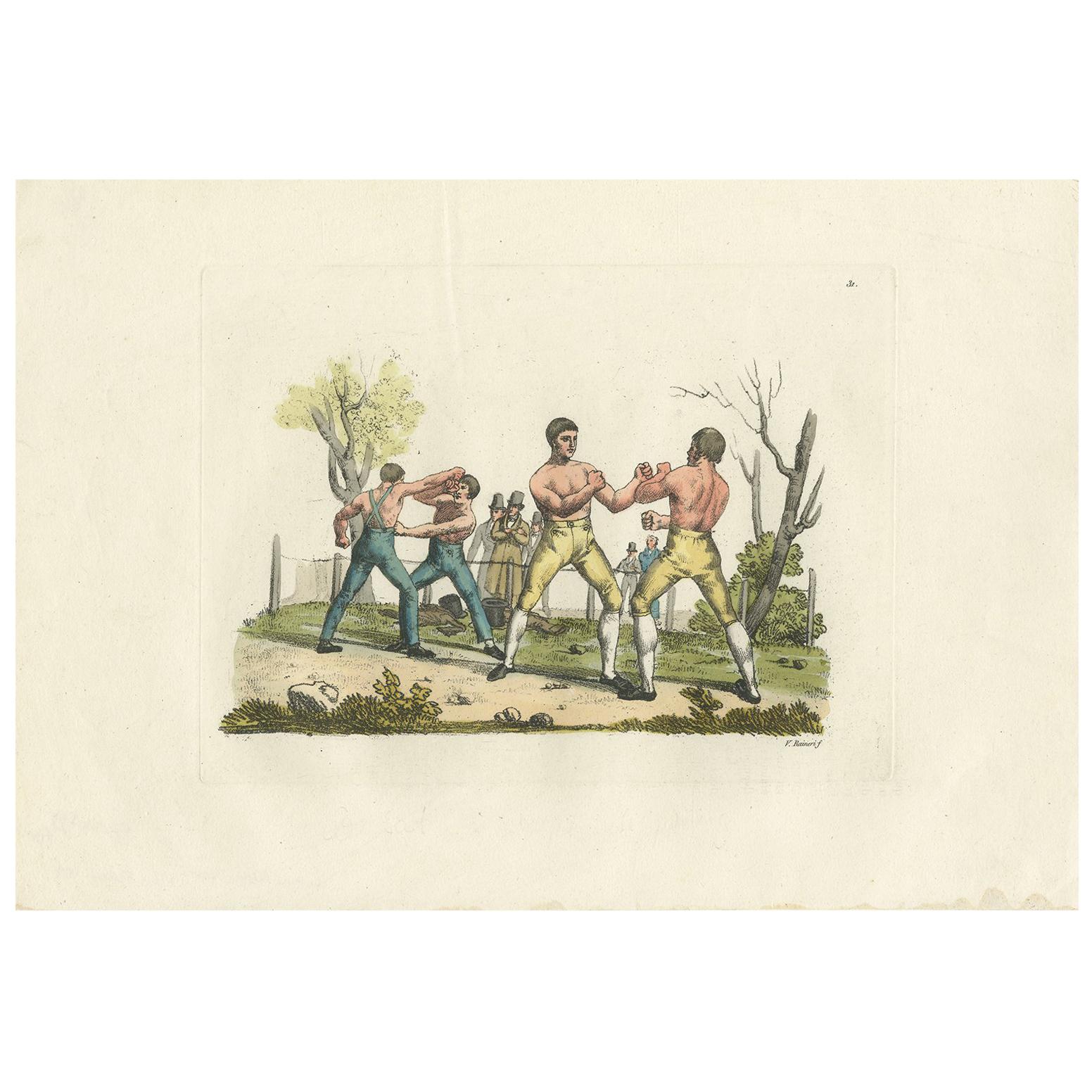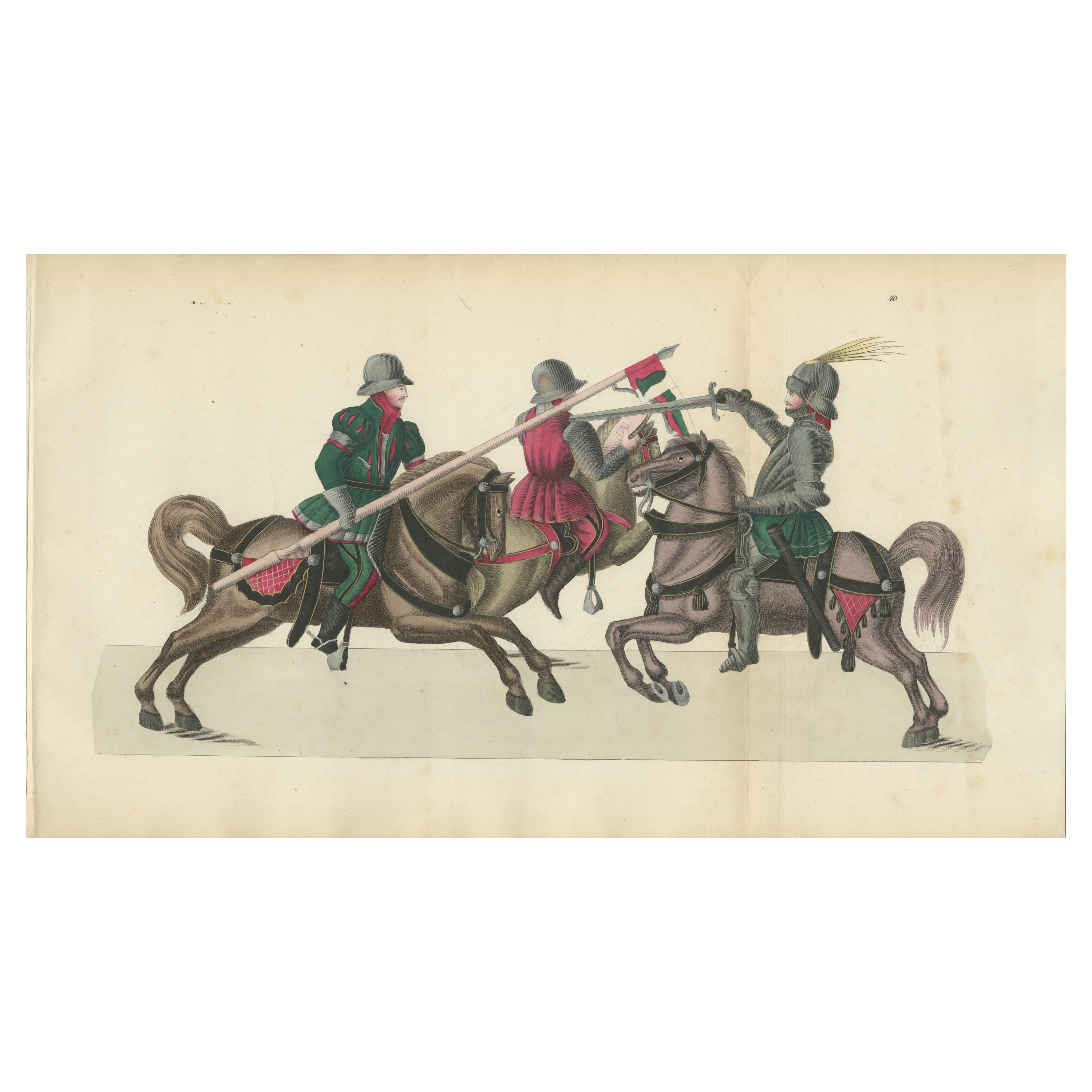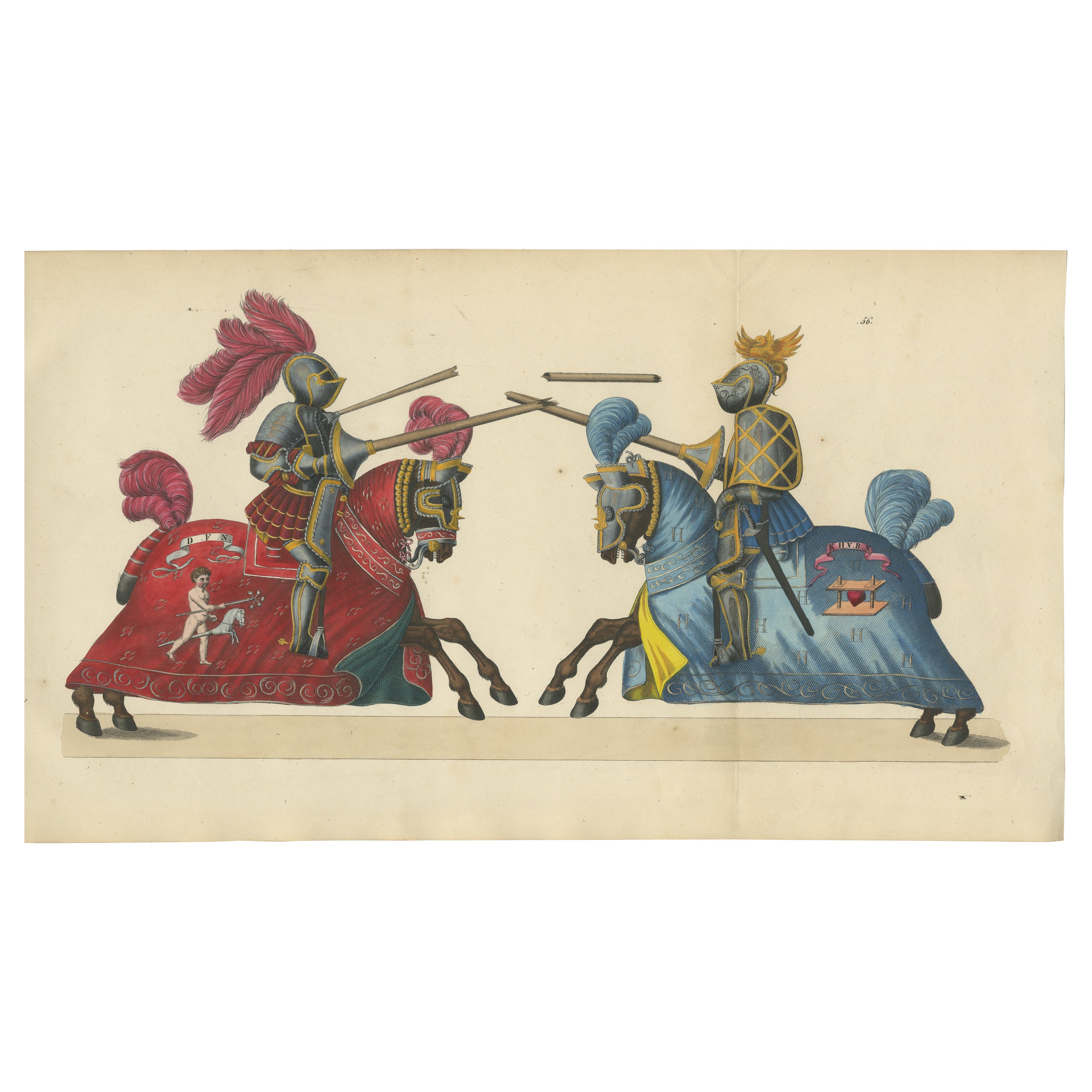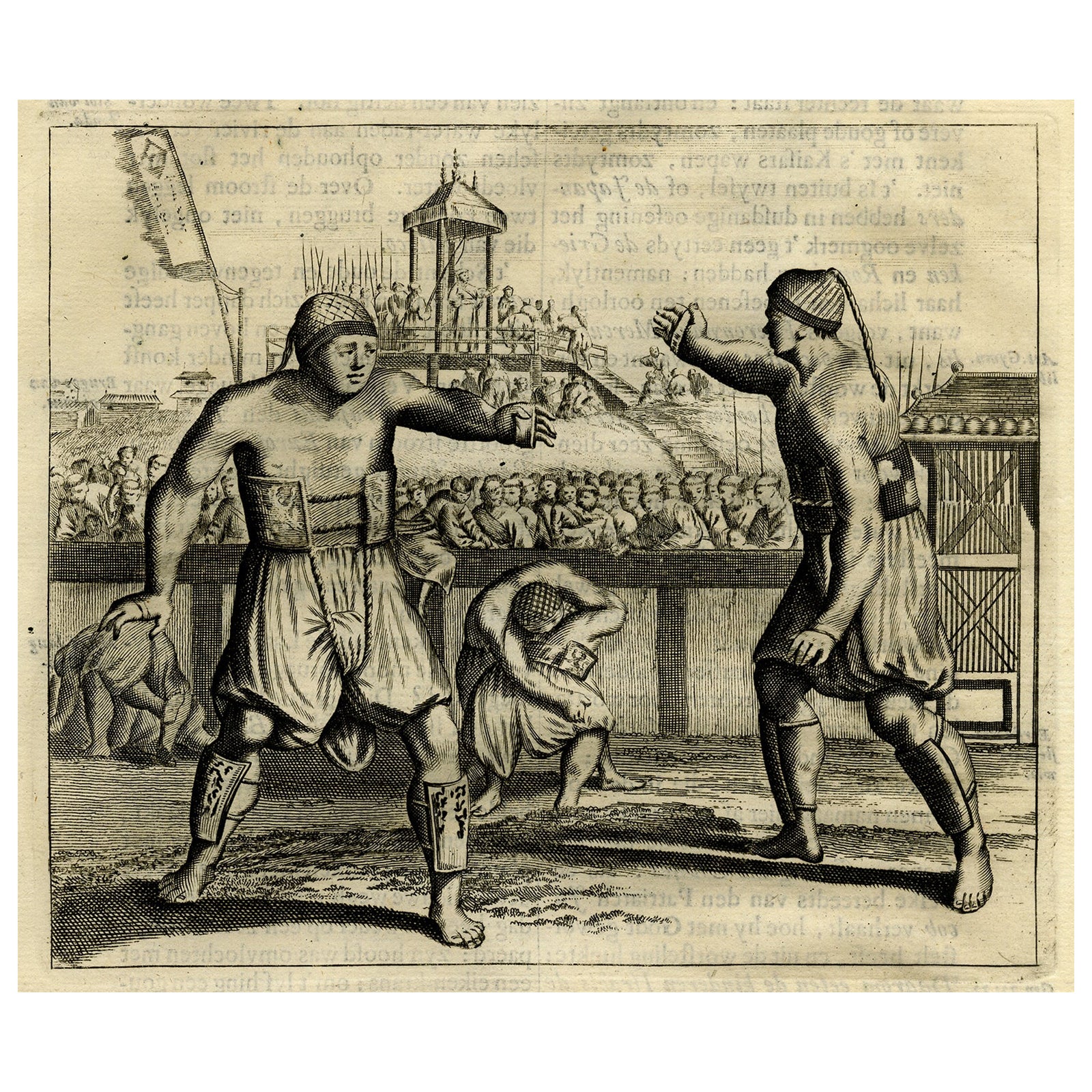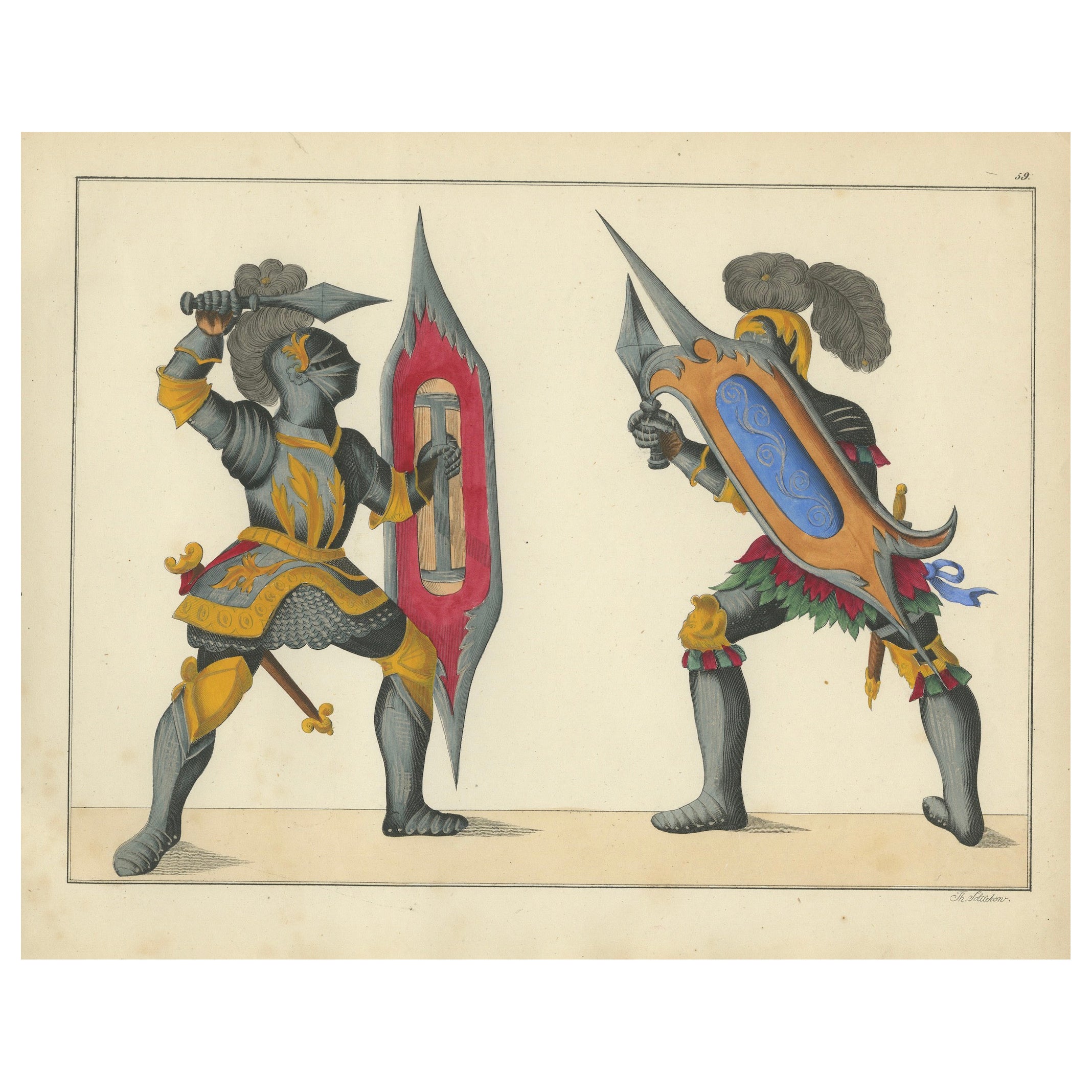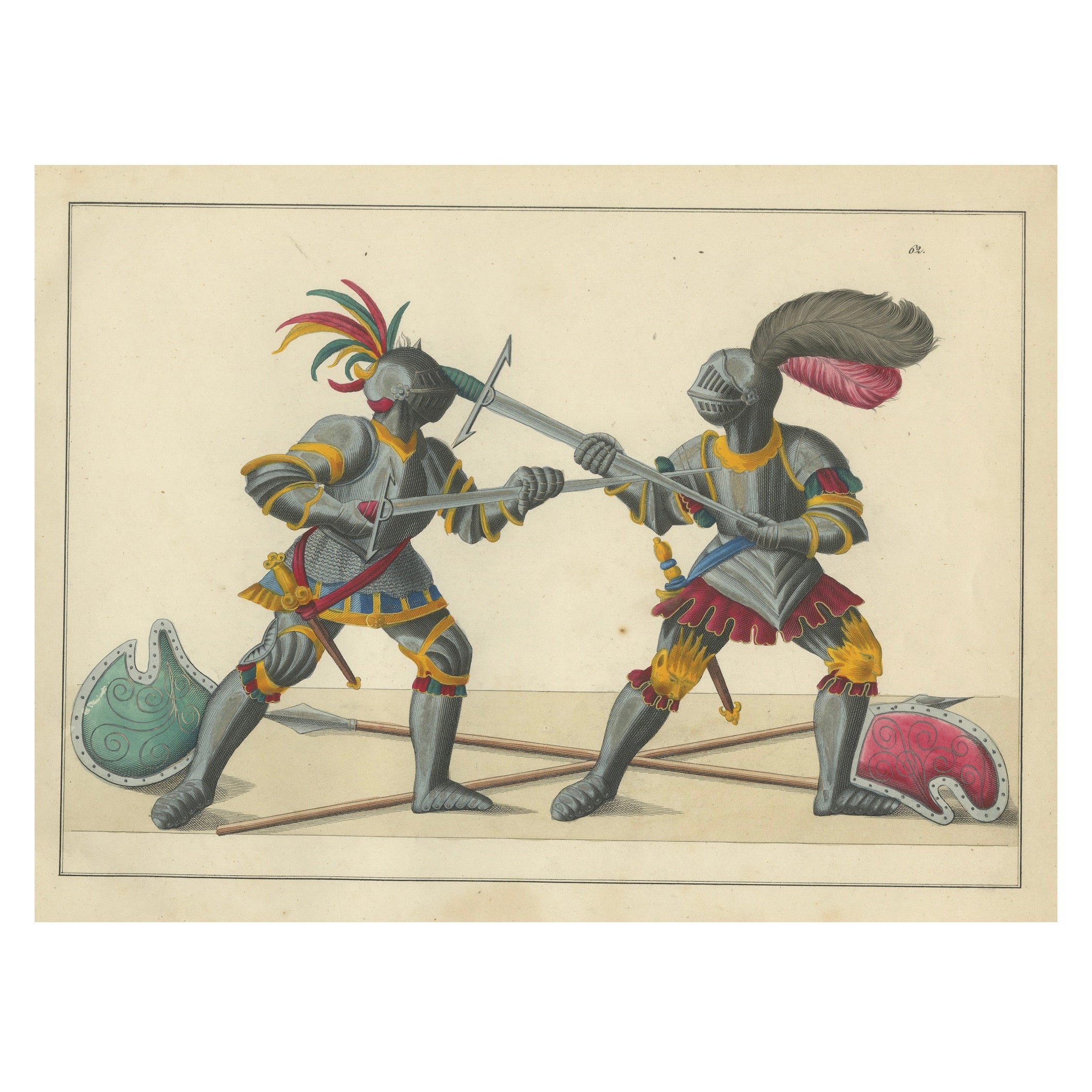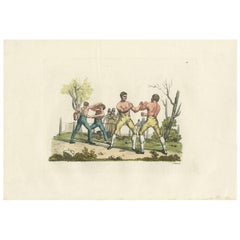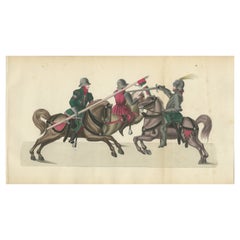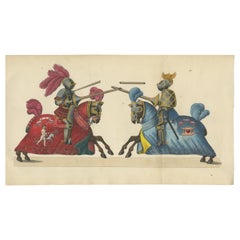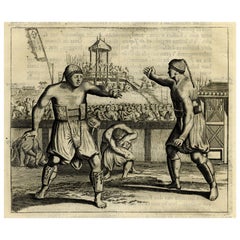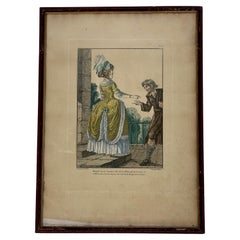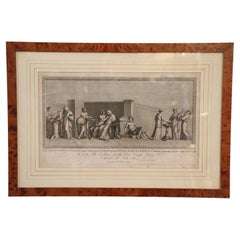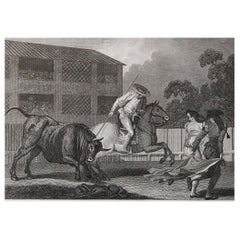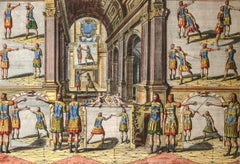Items Similar to 18th-Century Fencing Engraving – Elegant Depiction of Escrime Techniques
Want more images or videos?
Request additional images or videos from the seller
1 of 10
18th-Century Fencing Engraving – Elegant Depiction of Escrime Techniques
$381.73
£282.22
€320
CA$525.07
A$583.64
CHF 305.93
MX$7,127.70
NOK 3,819.40
SEK 3,593.35
DKK 2,436.15
About the Item
18th-Century Fencing Engraving – Elegant Depiction of Escrime Techniques
This exquisite 18th-century engraving, titled 'Escrime', presents a detailed depiction of fencing techniques through three distinct dueling scenarios. The composition, rendered with fine line work and enhanced by delicate hand-coloring, showcases duelists dressed in period attire, engaged in skillful combat. The print, marked as Pl. XII in the upper right corner, likely originates from an esteemed fencing manual or an encyclopedic work on martial arts and physical education.
Fencing, or 'Escrime', was a refined and highly regarded discipline in the 18th century, not only as a means of self-defense but also as a symbol of social status and gentlemanly conduct. The illustrated figures demonstrate various positions, parries, and attacks, each labeled numerically (Fig. 37, Fig. 38, and Fig. 39), suggesting that this plate served an instructional purpose. The attire of the fencers, including knee-breeches, waistcoats, and tricorn hats, is characteristic of the period, adding a striking historical dimension to the scene.
This engraving was executed with remarkable precision, with a clear emphasis on movement, anatomy, and the dynamic interaction between opponents. The background remains minimalistic, ensuring that the focus remains on the fencing techniques and postures. The lower margin bears the inscription Escrime, reinforcing the subject matter.
The print is in very good antique condition, with well-preserved hand-coloring that enhances the visual impact without overshadowing the fine engraving details. The paper has a warm, natural patina, consistent with its age. Some minor foxing and faint age-related toning are present, particularly in the margins, but these do not detract from the overall aesthetic appeal. The impression is crisp, with clear delineations of the figures and excellent preservation of the original ink work.
To best showcase this historical engraving, consider the following framing options. Use archival, acid-free matting in an off-white or lightly toned shade to complement the paper’s natural aging. A period-style frame in either gilded wood or dark-stained mahogany would enhance the antique character of the print. Opt for UV-resistant glass or acrylic to prevent fading and further aging of the hand-colored details. For a more dramatic presentation, float-mounting the print on a linen or silk mat would highlight its deckled edges and add depth to the display.
With careful framing, this engraving will not only be preserved for generations but also serve as a striking decorative piece, bringing 18th-century elegance and the artistry of fencing into any collection or interior.
- Dimensions:Height: 15.36 in (39 cm)Width: 9.69 in (24.6 cm)Depth: 0.01 in (0.2 mm)
- Materials and Techniques:Paper,Engraved
- Period:1760-1769
- Date of Manufacture:circa 1760
- Condition:The print is in very good antique condition, with well-preserved hand-coloring that enhances the visual impact without overshadowing the fine engraving details. The paper has a warm, natural patina, consistent with its age. Some minor foxing.
- Seller Location:Langweer, NL
- Reference Number:Seller: BG-13283-31stDibs: LU3054343906292
About the Seller
5.0
Recognized Seller
These prestigious sellers are industry leaders and represent the highest echelon for item quality and design.
Platinum Seller
Premium sellers with a 4.7+ rating and 24-hour response times
Established in 2009
1stDibs seller since 2017
2,604 sales on 1stDibs
Typical response time: <1 hour
- ShippingRetrieving quote...Shipping from: Langweer, Netherlands
- Return Policy
Authenticity Guarantee
In the unlikely event there’s an issue with an item’s authenticity, contact us within 1 year for a full refund. DetailsMoney-Back Guarantee
If your item is not as described, is damaged in transit, or does not arrive, contact us within 7 days for a full refund. Details24-Hour Cancellation
You have a 24-hour grace period in which to reconsider your purchase, with no questions asked.Vetted Professional Sellers
Our world-class sellers must adhere to strict standards for service and quality, maintaining the integrity of our listings.Price-Match Guarantee
If you find that a seller listed the same item for a lower price elsewhere, we’ll match it.Trusted Global Delivery
Our best-in-class carrier network provides specialized shipping options worldwide, including custom delivery.More From This Seller
View AllAntique Boxing Print by Raineri, 1819
Located in Langweer, NL
Untitled print depicting boxing men in England. This print originates from 'Costume Antico e Moderno' by Giulio Ferrario, published in Milan, 1819.
Category
Antique Early 19th Century Prints
Materials
Paper
$152 Sale Price
20% Off
19th-Century Hand-Coloured Lithograph of Mounted Combat with Spear and Sword
Located in Langweer, NL
19th-Century Hand-Coloured Lithograph of Mounted Combat with Spear and Sword
This original hand-coloured lithograph, produced in 1842, provides a vivid and dynamic glimpse into the...
Category
Antique 1840s Prints
Materials
Paper
Jousting Tournament: Knights in Armor with Splintering Lances in Combat, 1842
Located in Langweer, NL
The Jousting Tournament: Knights in Combat
Description: This hand-colored lithograph showcases an intense moment in a medieval jousting tournament, with two knights charging at ea...
Category
Antique 1840s Prints
Materials
Paper
Antique Engraving of Two Japanese Wrestlers Fighting, 1669
Located in Langweer, NL
Antique print, titled: 'Japansche worstelaars.' - ('Japanese wrestlers').
Two wrestlers cautiously approach each other in the middle of a ring. ...
Category
Antique 1660s Prints
Materials
Paper
$400 Sale Price
20% Off
19th-Century Hand-Coloured Lithograph of Duel with Ornate Shields and Daggers
Located in Langweer, NL
Title: 19th-Century Hand-Coloured Lithograph of Duel with Ornate Shields and Daggers
Description: This vivid and dynamic hand-coloured lithograph showcases two knights poised for c...
Category
Antique 1840s Prints
Materials
Paper
19th-Century Hand-Coloured Lithograph of Armoured Knights in Battle Scene
Located in Langweer, NL
Title: Original Hand-Coloured Knightly Combat Print from 'Der Rittersaal', Stuttgart, 1842
Description: This striking original hand-coloured lithograph originates from 'Der Ritter...
Category
Antique 1840s Prints
Materials
Paper
$706 Sale Price
20% Off
You May Also Like
French Engraving Hand Colored Galerie des Modes Costumes Francais, 1779.
Located in Vero Beach, FL
French Engraving Hand Colored Galerie des Modes Costumes Francais, 1779.
Rare antique French fashion print hand colored published first ...
Category
Early 20th Century French Baroque Prints
Materials
Paper
18th Century Antique Etching Print by Alessandro Mochetti
Located in Casale Monferrato, IT
Beautiful 18th century antique etching print with in walnut briar frame. Was etching by Alessandro Mochetti (1760 - 1812) was an Italian engrave...
Category
Antique 1780s Italian Prints
Materials
Paper
$1,717 Sale Price
20% Off
Original Antique Bullfighting Print, Dated 1805
Located in St Annes, Lancashire
Great image of bullfighting
Copper-plate engraving
Published 1805
Unframed.
Category
Antique Early 1800s English Folk Art Prints
Materials
Paper
Academie de l’Espee Tabula XXI by Girard Thibault 17thc fencing engraving
By Pierre Thibault
Located in Paonia, CO
Hand colored original engraving from the Academie de l’Espee ( full title can be translated as Academy of the Sword: wherein is demonstrated by mathematical rules on the foundation of a mysterious circle the theory and practice of the true and heretofore unknown secrets of handling arms on foot and horseback ) by Girard Thibault...
Category
17th Century Other Art Style Figurative Prints
Materials
Engraving
Battle - Lithograph - 19th century
Located in Roma, IT
Battle is an original Hand-colored lithograph on paper realized by an Anonymous artist of the XIX century.
Included two impressive images in one sheet. Titled in Italian on the low...
Category
19th Century Old Masters Figurative Prints
Materials
Lithograph
Spring and Langan English Boxing Scene Aquatint Etching
Located in Savannah, GA
Spring and Langan English boxing scene aquatint etching
Drawn and etched by James Clements & John Pitman
Worcester; Published March 22, 1824 by James Clements & John Pitman at 184 F...
Category
Antique 1820s English Georgian Prints
Materials
Paper
More Ways To Browse
Victorian Bulldog
Victorian Hand Belt
Victorian Iron Bed Frame
Vintage Ceramic Girl Figurines
Vintage Ceramic Mushrooms
Vintage Ceramic Rabbits
Vintage Concrete Tiles
Vintage Felt Doll
Vintage Glass Dressing Table Set
Vintage Glass Mannequin Head
Vintage Grape Boxes
Vintage Inuit Carvings
Vintage Lucite Mcm
Vintage Owl Ornaments
Vintage Porcelain Babies
Vintage Slipcovers
Vintage Striped Wool Blanket
Vintage Venetian Masks
